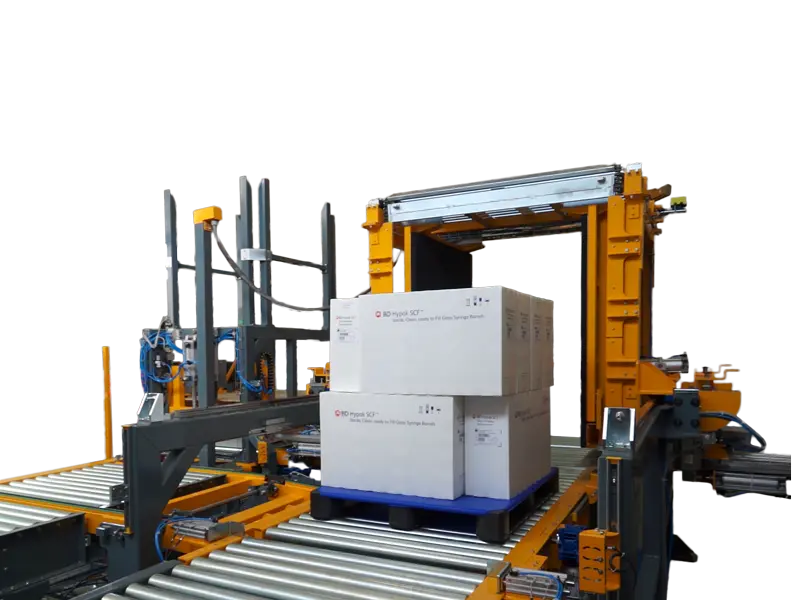Why Should You Consider Pallet Dispensers for Your Warehouse?
As someone who has dedicated decades to understanding the nuances of mechanical and electrical automation, the transformative potential of pallet dispensers is evident. These systems, epitomized by [Palomat Pallet Dispensers], offer an innovative solution that can significantly enhance material handling in warehouses. But how exactly do they fit into a busy industrial setting, and why should they matter to you?
What Problems Do Pallet Dispensers Solve?
The core challenge in many warehouses is optimizing the movement and management of pallets without succumbing to inefficiency and injury risks. Traditional manual handling can be hazardous, leading to back, foot, and finger injuries. These concerns often translate into workplace claims and productivity losses. Introducing an automated pallet management system like Palomat can:
- Mitigate injury risks associated with manual pallet handling.
- Liberate valuable space otherwise occupied by sporadic pallet stacks.
- Decrease the likelihood of pallet damage due to negligent handling.
Moreover, such systems pave the way for superior pallet management, integrating seamlessly with conveyor-facilitated operations.
What Differentiates Greenline Pallet Dispensers?
One of the standout models available is the [Greenline Pallet Stacker]. It sets itself apart through:
- Elimination of compressed air requirements.
- Capability of both stacking and destacking.
- User-friendly touch panel operations for effortless control.
The Greenline approach symbolizes not only an advancement in pallet stacking technology but also an environmental consideration by eschewing compressed air.
How Does the Flexomatic Adapt to Workflows?
For environments that demand versatility, the [Flexomatic Pallet Stacker] is a compelling choice:
- Automatic capability to switch between stacking and destacking.
- Operation facilitated by a mere touch.
- However, it requires both compressed air and electric power inputs.
This model adapts to diverse workflow needs, embodying an adept fusion of automation and manual versatility.
What Makes Pallet Stacker 5 a Heavyweight Champion?
For those seeking semi-automatic stacking solutions, the [Pallet Stacker 5] presents robust features:
- Effective for both stacking and destacking with autonomous detection.
- Ability to handle 1 to 5 pallets sequentially.
- Simple push-button operation, though reliant on compressed air and electric connections.
Such specifications make it adept for moderate to heavy operations while maintaining operational simplicity.

Can You Tailor Solutions for Non-Standard Pallets?
Yes, the adaptation to half or unique pallets, such as the [Half Pallets], is achieved through models designed for complete automatic handling. These systems offer:
- Full automation for stacking or destacking.
- Floor-level loading and unloading for ergonomic efficiency.
- Choices between purely electric or combinations with compressed air.
Competence in handling varied pallet sizes expands the operational capability of a facility.
Is Doubling Up on Pallets Worth the Investment?
For certain operations, the practice of utilizing [Double Up Stacker] is invaluable. It allows:
- Full automation tailored for doubled pallets.
- Seamless integration for floor-level processing.
- Flexibility in power configurations using either solely AC or in tandem with compressed air.
This model highlights an industrial commitment to doubling throughput efficiency without sacrificing control.
How Does the Inline Model Integrate with Conveyor Systems?
To enhance existing conveyor-based systems, the [Inline Pallet Stacker] offers:
- Automated capabilities for stacking or destacking beyond traditional methods.
- Integration readiness with existing PLC systems for streamlined operations.
- High-tech solutions enhancing both productivity and operational flow.
This appeals to those looking to unify new machinery within existing automated lines.
How Does Palomat Stand Out in the Competitive Market?
The global footprint of Palomat speaks volumes about its reliability and cost-efficiency. By leveraging economies of scale due to high production volumes, they offer competitively priced solutions without sacrificing quality.
- Simplified stacking and dispensing at optimal costs.
- Multiple control paradigms, from beginner-friendly to fully automated approaches.
- A hygienic stainless steel version available for specialized environments.
Are There Any Comparable Systems to Consider?
When thinking about pallet dispensers, one might also consider advanced automation systems like robotic palletizers and AGVs (Automated Guided Vehicles). These systems, while possibly on a higher investment level, offer additional dimensions of automation and flexibility, especially in high-demand sectors.
In conclusion, mechanical and electrical automation in pallet management, as exemplified by solutions like the Palomat, offers profound opportunities for efficiency and safety enhancements. Each setting has unique needs, and selecting the right model involves considering operational specifics and future scalability.

